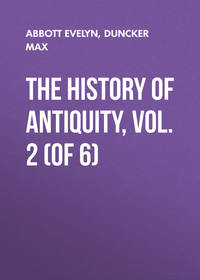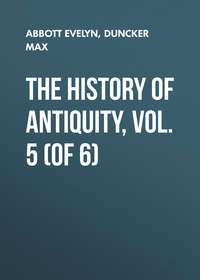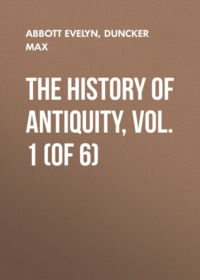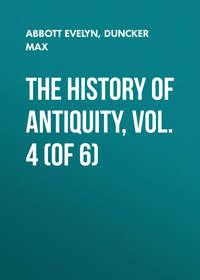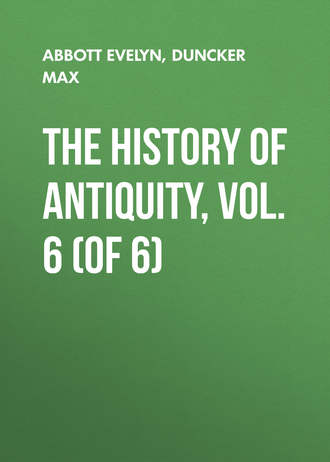 полная версия
полная версияThe History of Antiquity, Vol. 6 (of 6)
84
Herod. 3, 19; 5, 104, 110; 7, 96, 98, 128; Xenoph. "Ages." 2, 30; Diod. 16, 41. The rebellion of Sidon in 351 B.C. again reversed the relations.
85
1 Chron. iii. 17-19.
86
Ezra ii. 36-39.
87
Ezra ch. ii. As Babylon was conquered in the summer of 538, the first year of Cyrus in Babylon reaches to the summer of 537; Ezra i. 1, 3; Beros. fragm. 15, ed. Müller.
88
Deut. Isa. xlviii. 20.
89
Deut. Isa. lii. 7.
90
Deut. Isa. lii. 11.
91
Deut. Isa. lv. 12.
92
Deut. Isa. xlviii. 21.
93
Deut. Isa. li. 11.
94
Deut. Isa. liv. 6-10.
95
Deut. Isa. xlix. 19; lviii. 12.
96
Deut. Isa. liv. 11.
97
Deut. Isa. lx. 5.
98
Deut. Isa. lxvi. 12.
99
Deut. Isa. xlix. 17.
100
Deut. Isa. lx. 4-9.
101
Deut. Isa. liv. 2.
102
Deut. Isa. xlix. 22, 23.
103
Ewald, "Volk. Israel." 3, 91.
104
Ezra ii. 59-63.
105
Ezra iii. 8-13.
106
Ps. cxxix. – cxxxii.
107
Ezra iv. 1-5, 24. It is obvious that verse 24 must follow on verse 5 in chap. iv. The verses 6-23 treat of things which happened under Xerxes and Artaxerxes, and they have got into the wrong place.
108
Behist. 1, 6.
109
Arrian. "Ind." 1, 1.
110
Plin. "H. N." 6, 25; Ptolem. 6, 18.
111
Script. Alex. Magni; fragm. 23, ed. Müller.
112
Diod. 17, 81.
113
Strabo, p. 724; Arrian, "Anab." 3, 27, 4; 4, 4, 6.
114
Curtius, 7, 3, 1.
115
In Strabo, p. 686.
116
Arrian, "Anab." 4, 5.
117
Xenoph. "Cyri inst." 6, 6, 9; 8, 8, 20.
118
E. g. Ctes. "Pers." 43.
119
Herod. 3, 31; Xenoph. "Anab." 1, 6, 4; Esther i. 14.
120
Herod. 5, 25; 7, 194.
121
Herod. 1, 134.
122
Herod. 3, 154; 8, 85.
123
"Cyri inst." 8, 8, 1; 8, 2, 7.
124
Herod. 3, 75, 86, 160.
125
[125] "Persae," 768-770. "Transact. Bibl. Arch." 2, 148.
126
"Cyri inst." 8, 6, 9; 8, 8, 22, 23.
127
Plin. "H. N." 33, 15.
128
Arrian, "Anab." 3, 16; Curtius, 5, 2, 11; 6, 9, 6, 10; Diod. 17, 66, 71; Strabo, p. 731.
129
Diod. "Exc. vat." p. 33, 2, 44; Justin, 1, 8; 2, 3; 37, 3.
130
Arrian, "Anab." 5, 4. A similar story is in Frontin. "Strateg." 2, 5, 5.
131
Polyaen. "Strateg." 8, 28.
132
Çparheghapaeça, from çpareg, to shoot, spring, and paeça, piça, shape: Müllenhoff, "Monatsberichte Berl. Akad." 1866, s. 567.
133
Strabo, p. 514, 520; Plin. "H. N." 6, 16; Ptolem. 4, 20; Curtius, 3, 2; Diod. 2, 2; Steph. Byz. Δερβίκκαι.
134
Ctes. "Pers." 6-9.
135
"Cyri inst." 8, 7.
136
Ctes. "Pers." 7; Arrian, "Anab." 6, 28; Strabo, p. 730; Plin. "H. N." 6, 29; Plut. "Alex." 69. Curtius (10, 1) asserts after Cleitarchus, that when Alexander visited the tomb of Cyrus on his return from India, he only found the shield of Cyrus, then rotten, two Scythian bows, and a sword in the sepulchre.
137
In the wings, the clothing, and the peculiar head-dress this portrait (Tenier, "Descript." pl. 84) differs essentially from the representation of Darius and his successors at Persepolis and Naksh-i-Rustem. It is not Cyrus but his Fravashi which is here represented. The building at Murghab is somewhat like the description of the tomb of Cyrus given in the text, but the site will not allow us to regard it as the tomb at Pasargadae. It must be a building which one of his successors has dedicated to the memory of the great king. The profile in the relief confirms to some degree Plutarch's statement that Cyrus had an aquiline nose, and the Persians therefore considered beaked noses the most becoming: "Praec. ger. reip." c. 30. The nose of Darius, as we see it in the monuments, appears straighter and longer.
138
The Babylonian tablets give dates from the first to the ninth year inclusive of "Kuras, king of Babylon," which entirely agree with the dates of the canon of Ptolemy, i. e. with the capture of Babylon by Cyrus 538 B.C., and the death of Cyrus in 529 B.C. On another tablet, No. 877, Br. Mus., we find the "year eleven of Cambyses king of Babylon" (E. Schrader, "Z. Aegypt. Sprach." 1878, s. 40 ff.). It is a fact established by the canon of Ptolemy as well as by Herodotus that Cambyses did not sit on the throne for eight whole years. Tablet 906 explains this eleventh year; it runs as follows: "Babylon month Kislev, day 25, year 1 of Cambyses king of Babylon, at that time Cyrus king of the lands." Hence in Babylon dates were sometimes fixed by the years of Cyrus king of Babylon, and sometimes by the years of the viceroy. If the "year eleven" of Cambyses in Babylon was the year of Cambyses' death, Cyrus must have handed over the government of Babylonia to him in the year 532 B.C., i. e. three years before his own death. This view, which has been developed by E. Schrader, I feel able to adopt against the opinion of T. G. Pinches, who wrongly assumes an abdication of Cyrus. That years were not dated from Cambyses after his death is proved by seventeen other tablets, which do not go beyond the eighth year of his reign, and two others of the 20 Elul and 1 Tisri from the first year of Barziya, i. e. of the Pseudo-Smerdis.
139
Herod. 2, 182; Diod. 1, 68.
140
Herod. 3, 1.
141
Herodotus writes Kadytis after the Egyptian name Kazatu. Vol. I. 132.
142
Herod. 2, 1; 3, 44.
143
Bekker reads 7000.
144
Ctesias, "Pers." 9; Athenaeus, p. 560.
145
Strabo, p. 758.
146
In Herod. (3, 19) the voluntary submission of the Cyprians stands in direct connection with their participation in the campaign against Egypt; hence it cannot be placed earlier. If Xenophon ("Inst. Cyri," 1, 1) represents the Cyprians as already subjugated by Cyrus, he maintains the same of Egypt also. On the other hand, the statement of Xenophon that the Cyprians retained their native kings owing to their voluntary submission is amply confirmed by later events ("Inst. 2 Cyri." 7, 4, 2; 8, 6, 8).
147
Herod. 3, 44.
148
According to Lepsius, Amasis died in January 525, and hence Memphis fell in July of this year: "Monatsberichte Berl. Akademie," 1854. The Psammenitus of Herodotus is called Psammecherites in Manetho; and Psamtik on the monuments. Rosell. "Monum. storici." 2, 153; 4, 105.
149
Diod. "Exc. de virtute," p. 557; Polyaen. "Strateg." 7, 9. In regard to the campaign we may compare the march of Pharnabazus and Iphicrates against Nectanebos in the year 374 B.C., in Diod. 15, 41-43. Aristot. "Rhet." 2, 8, 12.
150
Herod. 2, 181. De Rougé, "Revue Archeol," 8, 3; Brugsch, "Hist. of Egypt," 2, 294.
151
Aristot. "Rhet." 2, 8, 12.
152
Herod. 2, 181.
153
Herod. 3, 37.
154
Herod. 3, 13.
155
Diod. "Exc. de legat." p. 619 = 10, 14.
156
Herod. 7, 69. Cf. Strabo, p. 802.
157
Herod. 3, 30.
158
Herod. 3, 17-26; Diod. 3, 1.
159
Vol. III. 63 ff. 159.
160
The name Miluhhi is nevertheless used so often in the inscription of the kings, and in such close connection with Egypt, that the kingdom of Napata may merely be meant. Assurbanipal tells us that his brother seduced into rebellion "the princes of Miluhhi whom he subjugated." Vol. III. 170.
161
Herod. 2, 29; Strabo, p. 786. Herodotus' statements, like those of the later authorities from Eratosthenes to Strabo and Pliny, have the second, more southern, Meroe in view, the ruins of which were found at Begerauieh, above the mouth of the Atbara, some 150 miles as the crow flies to the south of Napata. They describe this Meroe as situated on an island, because the Atbara was regarded as an arm of the Nile. The ruins at Begerauieh are less important and artistic than those of Napata, the hieroglyphics are of another kind. As the Persians maintained their hold on Napata, a new metropolis of the Ethiopian kingdom obviously grew up at this place after the times of Cambyses and Darius, which adopted the name and civilization of the old.
162
Strabo, p. 790; Diod. 1, 33.
163
"Antiq." 2, 10.
164
"Hymn." 26, 9.
165
"Hymn." 2, 146.
166
"Hymn." 7, 69.
167
"Hymn." 3, 97.
168
Diod. 3, 26, 33; Strabo, p. 772.
169
Plin. "H. N." 6, 35; Strabo, p. 822.
170
Herod. 2, 42.
171
Parthey, "Die Oase des Jupiter Ammon, Abh. Berl. Akad." 1862, s. 159 ff.
172
Belzoni, "Narrative," p. 398.
173
Ritter, "Erdkunde," 2, 1, 397.
174
Lepsius, "Trinuthis, Z. Aegypt. Sprache," 1874, s. 76 ff.
175
Herod. 3, 27-30.
176
Herod. 3, 37.
177
Vol. I. 175. Diod. 1, 49.
178
Justin. 1, 8.
179
The reading "year 4" in the first is confirmed by "year 5" in the second inscription. Lepsius ("Monatsberichte Berl. Akad." 1854, s. 224, 495) has examined the difficulties which arise regarding the time of Cambyses' campaign against Egypt, from the contradiction between these dates and the statements of the Greeks.
180
The inscriptions also give the name Cambyses in the form Kambuza.
181
Lepsius, "Z. Aegypt. Spr." 1874, s. 76.
182
De Rougé, "Revue Archéol." 8, 37 ff.; Brugsch, "Hist. d'Egypt," p. 267, 269. In the "History of Egypt," Brugsch reads Uzahorenpiris for Uzahorsun.
183
Stephen. Byz. Ἀγβάτανα Βάτανα Ἄμαθα. Cf. V. 307, and von Gutschmid, "N. Beitrage," s. 96.
184
Herod. 3, 3, 33.
185
"Excerpt. de virt." p. 557 = 10, 13.
186
Plato, "Legg." p. 691, 694, 695.
187
Herod. 3, 73.
188
Justin. 1, 9.
189
So Oppert according to the Persian inscription in "Journal Asiatique," 4, 17, 385, 386; and according to the second series, "Records of the Past," 7, 90.
190
Barziya in the Babylonian text. Smerdis, the favourite of Polycrates (Anacreon, fragm. 4, ed. Bergk), was no doubt named after the brother of Cambyses.
191
Sachau, "Albiruni," p. 205; Nöldeke, "Tabari," s. 91, 271.
192
Elul and Tisri fall in September and October. The last year of Cambyses is 522 B.C. According to Herodotus, Cambyses reigned seven years and five months, and the Magian more than seven months; the two make up eight years. The number of the Persian days of the month are repeated in the Babylonian version of the Behistun inscription. Hence the Persians adopted the year of the Assyrians and Babylonians as well as their cuneiform writing, but they had independent names for the months. Unfortunately the names of the months in the Babylonian text are more frequently destroyed than not, so that we can only be certain in giving Kislev (November-December) as corresponding to the Athriadiya of the Persians, Tebet (December-January) to Anamaka, Iyar (May-June) to Taigarshis. Oppert maintains that we can also identify the Babylonian Adar or Veadar (Febr. – March) with the Viyakhna of the Persians; but the text is uncertain in this passage. Finally, we may with tolerable certainty regard Garmapada (i. e. the path of heat) as corresponding to July and August, to the Tammuz or Ab of the Babylonians. If Viyakhna is really Adar, the proclamation of the Magian took place in March, 522 B.C., and his coronation in Garmapada (July and August). This according to Darius was followed by the death of Cambyses. The two tablets quoted date from September and October in the first year of Barziya. According to Herodotus, the Magian reigned more than seven months after the death of Cambyses, i. e. down to the spring of 521 B.C. According to the inscription of Behistun, Darius slew him on the tenth of Bagayadis (i. e. sacrifice to the gods), which would thus be parallel to the Nisan of the Babylonians, i. e. to our April.
193
Herod. 4, 166.
194
"Antiqu." 11, 2.
195
Herod. 3, 89.
196
Herod. 5, 25.
197
Herod. 3, 88; 7, 78.
198
Ctes. "Pers." 13. The names of the Seven in Ctesias have been discussed already, Vol. V. 329 n.
199
Herod. 3, 83, 84, and below, p. 221, 222.
200
Herod. 4, 83; 5, 25, 30.
201
Vol. V. 326 n.
202
Herod. 3, 72, 77.
203
Spiegel, "Keilinschriften," s. 7, "to say;" so Oppert ("Peuple des Mèdes," p. 110) after the Turanian version; on the other hand Mordtmann in "Z. D. M. G." 16, 37 gives, "to undertake."
204
Spiegel, "Keilinschriften," s. 81 ff.; Oppert, loc. cit. p. 121.
205
Herodotus gives Aspathines or Aspathenes; the inscription on the tomb of Darius mentions Açpachana as holding an honourable office near the person of the king.
206
Herod. 3, 67.
207
Herod. 3, 139, 126, 127.
208
See below, p. 229.
209
Plutarch, "Praec. gerend. reip." c. 27; Polyaen. "Strateg." 7, 12.
210
Herod. 7, 2; Behist. 4, 84; 5, 7, 9. N. R. c.
211
G. Rawlinson's view, which he gives in an excursus to his Herodotus (2, 548 ff.) – that the Magian was not a Mede, I accept, as I have observed, p. 191. Darius says in the inscription of Behistun that neither a Persian nor a "Mede" had risen against Gaumata, and moreover, that he had recovered the dominion which had been taken "from his tribe" and "race." But in no case was it a question of a religious conflict, but rather to avoid a new struggle between Media and Persia. On the passage 3, 14 in the inscription all that need be said has been given already (p. 216).
212
Herod. 3, 80-88.
213
Justin. 1, 10.
214
Ctes. "Pers." 14.
215
Sext. Empir. "Adv. Rhet." 33 in Stein, Herod. 3, 80.
216
Herod. 6, 43.
217
The evidence in support of this will be found in the Greek History.
218
Above, p. 195, n.
219
Herod. 3, 67, 126, 150.
220
He was, according to Herodotus, twenty years old at the death of Cyrus. Herod. 1, 209; 3, 139. Ctesias ("Pers." 19) gives Darius a reign of thirty-one years and a life of seventy-two. That the reign of Darius lasted thirty-six years is fixed both by the astronomical canon and Egyptian inscriptions, which mention the thirty-sixth year of Darius; and lastly by the Egibi-tablets of Babylon, which give dates out of thirty-five years (with the single exception of the seventh year). "Transact. Bibl. Arch." 6, 69 ff. According to Ctesias, Darius would be thirty-six years old in the year 521 B.C.
221
Herod. (3, 118, 119) puts this event; αὐτίκα μετὰ τὴν ἐπανάστασιν.
222
Herod. 1, 130.
223
Justin repeats the narrative of Herodotus in a rhetorical form; he incorrectly regards Zopyrus as one of the seven. Diodorus attempts to unite the statements of Herodotus and Ctesias, by maintaining that Zopyrus was also called Megabyzus; the "twenty Babylons" are reduced to ten. (Exc. Vat. p. 34, 35 = 10, 19.) In Herod. (4, 143) Darius wishes when he opens the finest pomegranate that he had as many Megabyzuses (the father of Zopyrus is meant) as the fruit had seeds. Plutarch transfers this to Zopyrus, and represents Darius as saying that he would rather have Zopyrus uninjured than 100 Babylons; "Reg. Apophthegm." 3. In Polyaenus (7, 12), Zopyrus imitates the device which Sirakes, a Sacian, had previously employed against Darius, and opens the gates of Babylon to the Persians by night.
224
Thucyd. 1, 104, 109, 110; Diod. 11, 71, 74, 75, 77; 12, 3; Isocr. "De Pace," 82.
225
Ctes. "Pers." 44. The paidagogos of Alcibiades was no doubt named after this Zopyrus. Plutarch, "Lycurg." c. 16; Alcib. c. 1; Kirchhoff, "Enstehungszeit," s. 15.
226
E. g. Ménant, "Babylon," p. 204; Oppert. "Expéd." 1, 187, 223.
227
So according to the Babylonian text in Schrader, "Keilinschriften," s. 345.
228
Oppert after the Turanian text: "I slew much people from the army of Nidintabel, and drove others to the river; they were drowned in the river."
229
The Turanian version mentions Egypt after Assyria. In the inscription nothing is said of this country; no Egyptians are found in the rows of the conquered rebels.
230
The two Egibi-tablets quoted by Boscawen in "Trans. Bibl. Arch." 6, 68, on Nebuchadnezzar III. have been rightly ascribed by Oppert, relying on the names of the witnesses, to the later rebellion of Arakha.
231
Cf. Schrader, "Keilinschriften," s. 346.
232
Schrader, loc. cit. s. 346. The day of the month belongs to the corresponding Babylonian month Tebet.
233
Mordtmann, loc. cit. s. 75; Schrader, loc. cit. s. 347.
234
Above, Vol. V. 323. The district of Otene belongs no doubt to Armenia. Steph. Byz. sub voce.
235
What Herodotus relates of Zopyras, Ctesias relates of his son Megabyzus II. in regard to this new rising, of which we have no more accurate knowledge in any other source, but which must not be called in question. Herodotus himself indicates a rebellion under Xerxes, in which the golden image of Belus was taken away from the lower chamber in the great temple (1, 183), and we have Strabo's statement of the destruction of Belus by Xerxes, p. 738. If Darius, as Herodotus tells us, 3, 159, "destroyed the gates of Babylon," it does not follow that he opened the supposed tomb of Nitocris over the main gateway, because it made it impassable, as Herodotus thinks (1, 187).
236
Vol. V. p. 10, n.
237
Oppert, "Peuple des Mèdes," p. 133.
238
Mordtmann, loc. cit. s. 76, 77; Spiegel, "Altpers. Keilinschriften," Bag. 3, 3; Schrader, loc. cit. s. 351.
239
Oppert, "Records of the Past," 7, 104. The date of this rebellion cannot be accurately fixed. The passage in the inscription of Behistun which bears upon it stands at the close of the connected narrative; we should therefore have to assume that it took place in the year 517 B.C., for this passage begins with the words, "When I was in Persia and Media," which in the connection can only have the meaning: When I was occupied with the overthrow of Phraortes and Vahyazdata. On the other hand the Egibi-tablets are wanting for the seventh year of Darius only, so that according to this the year 515 B.C. would be the year of the rebellion of Arakha. Above, p. 240, n.
240
Polyaen. 7, 27.
241
Oppert, "Peuple des Mèdes," p. 158, inserts at the beginning of this fifth column of the inscription of Behistun before thardam: duvadaçamam, so that we get the meaning; "This is what I have done up to the twelfth year." The eleventh year of Darius ends in spring 510. But chronological dates are not to be obtained by merely emending the text. According to the context and the first line of Col. v. Darius said in reference to the four preceding columns: "This I have done up to this or that year." Then follows the narrative of the new rebellion of the Babylonians and the subjugation of the Sacæ. If the rebellion of Arakha took place in the seventh year of Darius, as Oppert himself assumes, we should rather insert astemam before thardam.
242
Diodor. 2, 13; 17, 110. Suidas Βαγίστανον ὄρος. Ritter, "Erdkunde," 9, 350.
243
Spiegel, "Keilinschriften," s. 31 ff. Oppert in the "Journal Asiatique," S. 4, VOL XVII., 322 ff., and "Peuple des Mèdes," p. 151 ff., Col. iv. 19. Oppert after a Turanian version above the picture here translates as follows: "Et Darius le roi dit: par la grâce d'Ormuzd j'ai fait une collection de textes ailleurs en langue arienne, qui autrefois n'existait pas. Et j'ai fait un texte de la loi et un commentaire de la loi et la bénédiction et les traductions. Et ce fut écrit et je le promulgai en entier, puis je rétablis l'ancien livre dans tous les pays et les peuples le reconnurent."


